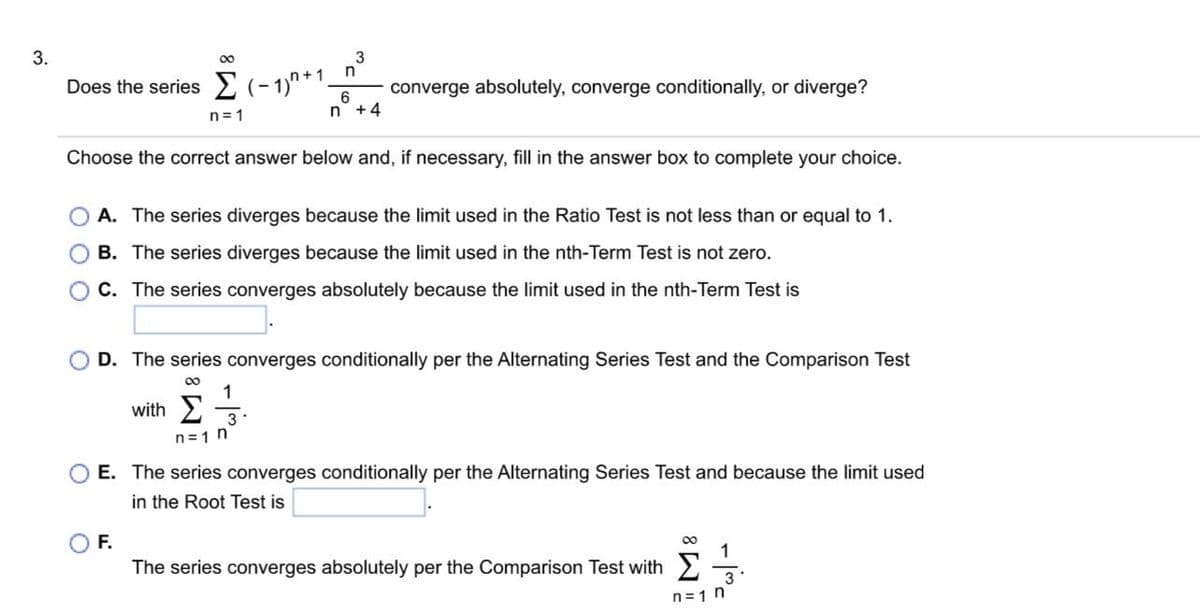3. ∞ Does the series (-1)+1 converge absolutely, converge conditionally, or diverge? 6 n +4 Choose the correct answer below and, if necessary, fill in the answer box to complete your choice. n=1 with Σ O F. A. The series diverges because the limit used in the Ratio Test is not less than or equal to 1. B. The series diverges because the limit used in the nth-Term Test is not zero. OC. The series converges absolutely because the limit used in the nth-Term Test is 3 D. The series converges conditionally per the Alternating Series Test and the Comparison Test 8 1 n n=1 n 3. O E. The series converges conditionally per the Alternating Series Test and because the limit used in the Root Test is The series converges absolutely per the Comparison Test with ∞ ³w|- n=1 n
3. ∞ Does the series (-1)+1 converge absolutely, converge conditionally, or diverge? 6 n +4 Choose the correct answer below and, if necessary, fill in the answer box to complete your choice. n=1 with Σ O F. A. The series diverges because the limit used in the Ratio Test is not less than or equal to 1. B. The series diverges because the limit used in the nth-Term Test is not zero. OC. The series converges absolutely because the limit used in the nth-Term Test is 3 D. The series converges conditionally per the Alternating Series Test and the Comparison Test 8 1 n n=1 n 3. O E. The series converges conditionally per the Alternating Series Test and because the limit used in the Root Test is The series converges absolutely per the Comparison Test with ∞ ³w|- n=1 n
Calculus: Early Transcendentals
8th Edition
ISBN:9781285741550
Author:James Stewart
Publisher:James Stewart
Chapter1: Functions And Models
Section: Chapter Questions
Problem 1RCC: (a) What is a function? What are its domain and range? (b) What is the graph of a function? (c) How...
Related questions
Question

Transcribed Image Text:3.
∞
3
Does the series (-1)+1. converge absolutely, converge conditionally, or diverge?
6
n +4
Choose the correct answer below and, if necessary, fill in the answer box to complete your choice.
n=1
n
F.
A. The series diverges because the limit used in the Ratio Test is not less than or equal to 1.
B. The series diverges because the limit used in the nth-Term Test is not zero.
C. The series converges absolutely because the limit used in the nth-Term Test is
D. The series converges conditionally per the Alternating Series Test and the Comparison Test
∞
1
with Σ 3
n=1 n
E. The series converges conditionally per the Alternating Series Test and because the limit used
in the Root Test is
The series converges absolutely per the Comparison Test with
8
³w|-
n=1 n
Expert Solution
This question has been solved!
Explore an expertly crafted, step-by-step solution for a thorough understanding of key concepts.
This is a popular solution!
Trending now
This is a popular solution!
Step by step
Solved in 2 steps with 2 images

Recommended textbooks for you

Calculus: Early Transcendentals
Calculus
ISBN:
9781285741550
Author:
James Stewart
Publisher:
Cengage Learning

Thomas' Calculus (14th Edition)
Calculus
ISBN:
9780134438986
Author:
Joel R. Hass, Christopher E. Heil, Maurice D. Weir
Publisher:
PEARSON

Calculus: Early Transcendentals (3rd Edition)
Calculus
ISBN:
9780134763644
Author:
William L. Briggs, Lyle Cochran, Bernard Gillett, Eric Schulz
Publisher:
PEARSON

Calculus: Early Transcendentals
Calculus
ISBN:
9781285741550
Author:
James Stewart
Publisher:
Cengage Learning

Thomas' Calculus (14th Edition)
Calculus
ISBN:
9780134438986
Author:
Joel R. Hass, Christopher E. Heil, Maurice D. Weir
Publisher:
PEARSON

Calculus: Early Transcendentals (3rd Edition)
Calculus
ISBN:
9780134763644
Author:
William L. Briggs, Lyle Cochran, Bernard Gillett, Eric Schulz
Publisher:
PEARSON

Calculus: Early Transcendentals
Calculus
ISBN:
9781319050740
Author:
Jon Rogawski, Colin Adams, Robert Franzosa
Publisher:
W. H. Freeman


Calculus: Early Transcendental Functions
Calculus
ISBN:
9781337552516
Author:
Ron Larson, Bruce H. Edwards
Publisher:
Cengage Learning